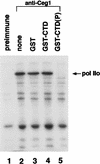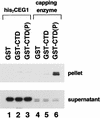mRNA capping enzyme is recruited to the transcription complex by phosphorylation of the RNA polymerase II carboxy-terminal domain
- PMID: 9407025
- PMCID: PMC316800
- DOI: 10.1101/gad.11.24.3319
mRNA capping enzyme is recruited to the transcription complex by phosphorylation of the RNA polymerase II carboxy-terminal domain
Abstract
Capping of mRNA occurs shortly after transcription initiation, preceding other mRNA processing events such as mRNA splicing and polyadenylation. To determine the mechanism of coupling between transcription and capping, we tested for a physical interaction between capping enzyme and the transcription machinery. Capping enzyme is not stably associated with basal transcription factors or the RNA polymerase II (Pol II) holoenzyme. However, capping enzyme can directly and specifically interact with the phosphorylated form of the RNA polymerase carboxy-terminal domain (CTD). This association occurs in the context of the transcription initiation complex and is blocked by the CTD-kinase inhibitor H8. Furthermore, conditional truncation mutants of the Pol II CTD are lethal when combined with a capping enzyme mutant. Our results provide in vitro and in vivo evidence that capping enzyme is recruited to the transcription complex via phosphorylation of the RNA polymerase CTD.
Figures




Comment in
-
Transcription units as RNA processing units.Genes Dev. 1997 Dec 15;11(24):3279-85. doi: 10.1101/gad.11.24.3279. Genes Dev. 1997. PMID: 9407022 Review. No abstract available.
References
-
- Cadena DL, Dahmus ME. Messenger RNA synthesis in mammalian cells is catalyzed by the phosphorylated form of RNA polymerase II. J Biol Chem. 1987;262:12468–12474. - PubMed
-
- Colot HV, Stutz F, Rosbash M. The yeast splicing factor Mud13 is a commitment complex component and corresponds to CBP20, the small subunit of the nuclear cap-binding complex. Genes & Dev. 1996;10:1699–1708. - PubMed
-
- Dantonel JC, Murthy KGK, Manley JL, Tora L. Transcription factor TFIID recruits factor CPSF for formation of 3′ end of mRNA. Nature. 1997;389:399–402. - PubMed
Publication types
MeSH terms
Substances
LinkOut - more resources
Full Text Sources
Other Literature Sources
Molecular Biology Databases
